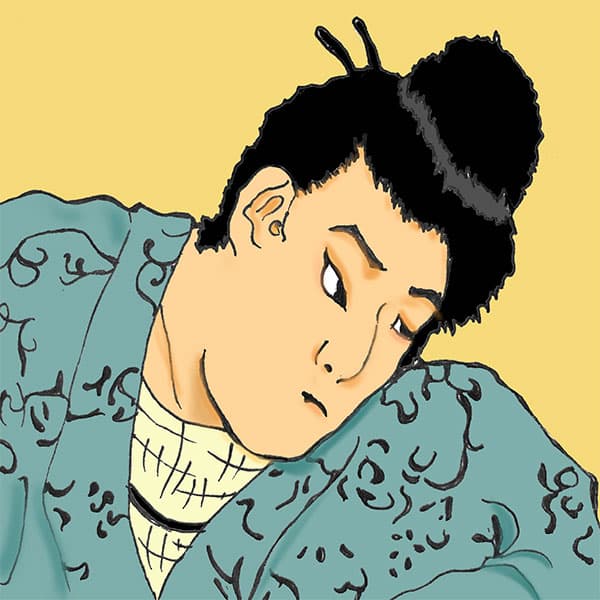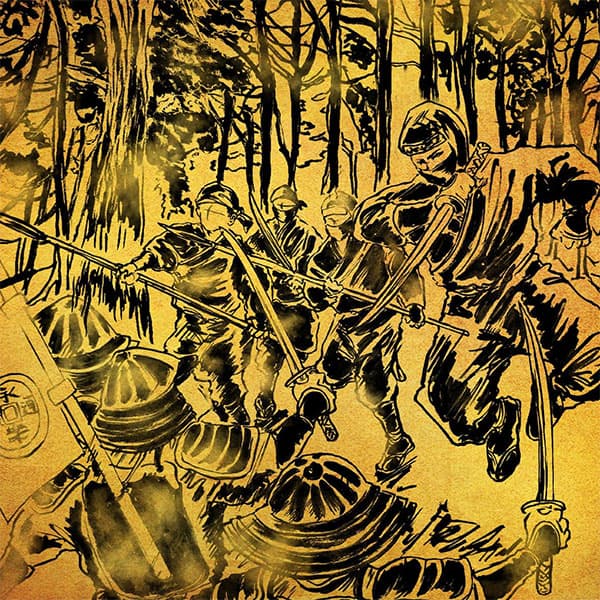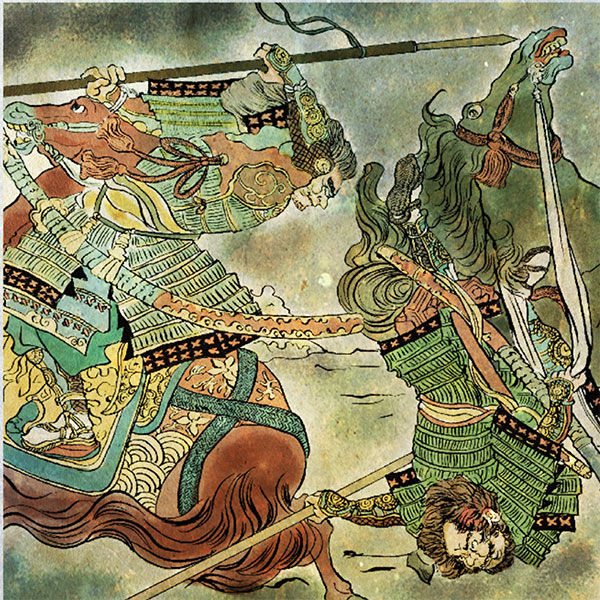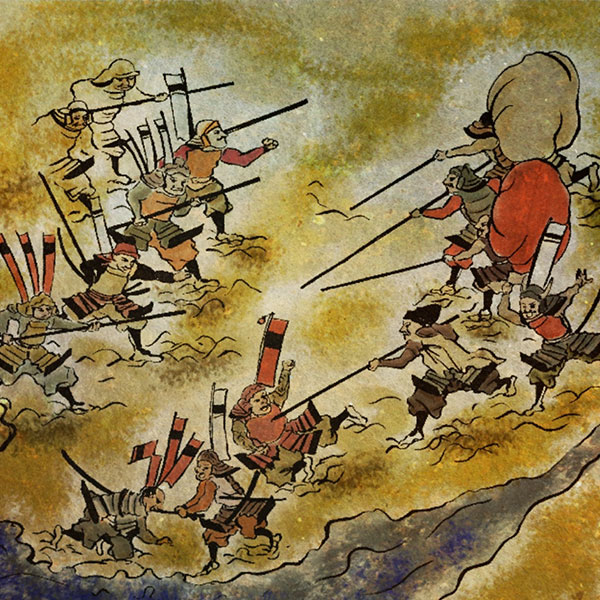Sadatsugu Tsutsui (1/2)Kaiki Daimyo ~ The first lord of Iga Ueno Castle hidden in the shadow of Todo Takatora

Sadatsugu Tsutsui
- Article category
- biography
- name
- Tsutsui Sadatsugu (1562-1615)
- place of birth
- Mie Prefecture
- Related castles, temples and shrines

Iga Ueno Castle
Do you know the Sengoku daimyo named Sadatsugu Tsutsui? He was the successor of Junkei Tsutsui, who was famous for feuding with Hisashi Matsunaga and taking advantage of opportunism rather than joining Mitsuhide Akechi during the Honnoji Incident.He served Toyotomi Hideyoshi, and as a result of siding with the Eastern Army led by Ieyasu Tokugawa at the Battle of Sekigahara, He is a military commander entrusted with the entire Iga province.
Sadatsugu Tsutsui was the one who built Iga Ueno Castle, which Todo Takatora was involved in, but after the Battle of Sekigahara, he was forced to change his lordship, and then he was forced to commit seppuku because he was in contact with the Toyotomi side. Compared to Takatora Todo, who rose to the top of his game efficiently, his end was very sad. This time, we will follow the life of Sadatsugu Tsutsui.
Adopted by Junkei Tsutsui and inherited the Tsutsui family.
Sadatsugu Tsutsui was born in 1562 as the second son of Junkoku Jimeiji (Junkuni Tsutsui), whose home was Izumi Province (Osaka Prefecture). Afterwards, Junkei Tsutsui (his uncle and cousin), the head of the family, had no children, so he became his adopted heir. It is said that he was liked by Nobunaga Oda, and he married his 14th daughter.
After Nobunaga's death, Junkei served Toyotomi Hideyoshi, and Sadatsugu ended up spending time as a hostage in Osaka Castle. In 1584, he participated in the Battle of Komaki and Nagakute with Junkei, and due to Shigenobu Matsukura, a vassal of Sadatsugu, who fought bravely, he was appointed Ukon no Taifu.
When Junkei died of illness at the age of 36 in 1584, he succeeded him at the age of 26 and became the lord of Yamatokoriyama Castle (Nara Prefecture). He was also allowed to use the surname Hashiba and was appointed Jugoi (Junior Fifth Rank, Lower Iga no Kami).
During the Kishu Conquest in 1585, he fought a great battle with Hidemasa Hori and others, attacking Sengokubori Castle. In the Shikoku attack, he served as the vanguard along with Hajime Nakamura and Masakatsu Hachisuka, and was active in attacking Kizu Castle.
Delegation? Prosperity? The mystery of changing countries
In 1585, Toyotomi Hideyoshi carried out a large-scale change of country. This was done to solidify his base in Kinai with his relatives and close aides, but as a result Sadatsugu Tsutsui moved his territory from Yamato Province to Iga Ueno (Mie Prefecture). Hideyoshi's younger brother Toyotomi Hidenaga entered Yamato Province.
Regarding the change of country, there was a dispute between Toyotomi Hideyoshi's younger brother who had entered Yamato Province, and the fact that the vassals were about to split due to a dispute between the temple and shrine powers in Yamato Province and Sadatsugu Tsutsui. There is a theory that says, "Isn't it?" There is also evidence that the stone value of Iga Ueno, which was the destination of the change of country, was only 50,000 koku, which was a significant decrease from Yamato Province.
On the other hand, according to materials from the Edo period, out of the 450,000 koku of Yamato before the change of country, the Tsutsui clan's koku of 180,000 koku excluding Yoriki was 180,000 koku, and when the country was changed to Iga, 120,000 koku of Iga, and 120,000 koku of Ise. It is written that he was given 50,000 koku, and 30,000 koku within Yamashiro, a total of 200,000 koku. An increase of 20,000 koku, in other words, a promotion.
Iga is an important base for protecting Osaka, Toyotomi's stronghold, and preparing for the Kanto region, so it can be said that this is proof that Hideyoshi valued Sadatsugu, but there is some debate as to which is correct.
A military commander abandoned by Shima Sakon
A famous subordinate of Tsutsui Sadatsugu is Shima Sakon, a fierce general known as the ``demon Sakon.'' Although he was a famous general who later served Ishida Mitsunari and died in battle with Mitsunari at Sekigahara, he was originally a senior vassal of Tsutsui Junkei.
As mentioned above, when Sadatsugu moved his territory to Iga Ueno, conflicts among his vassals intensified. However, it seems that Teiji lacked the power to control it properly. Meanwhile, a conflict arose between Sadatsugu's most important vassals, Shusuke Nakabo and Sakon Shima over irrigation water.
According to one theory, the cause was that Shusuke dammed the irrigation canal during the summer water shortage, and water no longer came to the rice fields in Sakon's territory. Sakon asked Shusuke to stop damming the irrigation canal, but when he was not listened to, he built a new irrigation canal, but as a result, water no longer came to the rice fields in Shusuke's territory, and Shusuke appealed directly to Sadatsuki. Thing.
Sadatsugu, who highly valued Shusuke, ruled that Sakon was at fault. Angered by the ruling in favor of Shusuke, Sakon decided to leave the Tsutsui family.
There is also a story that Sakon remonstrated with Sadatsugu, who was addicted to lust, but when Sadatsugu refused to listen, he acted out of his favor as a master.
Other powerful vassals such as Shigemasa Matsukura, Yoshitaka Mori, and Yoshiharu Fuse also left the Tsutsui family around the time Sakon did, and it is said that the rise of the Hidesuke clan was behind this.
By the way, Shusuke will be mentioned later, but he is an indispensable key person when talking about Sadatsugu Tsutsui's fate. Sakon is so highly regarded that it has been said that ``There are two things that surpass Mitsunari: Sakon on the island and the castle on Sawayama.'' If Sadatsugu had not given preferential treatment to his favorite vassal Hidesuke, Sakon, who was highly skilled as a staff officer, might not have left the Tsutsui family and his subsequent decline might not have happened.
continue to be active in battle
In 1586, there was a conquest of Kyushu, but Tsutsui Sadatsugu left Iga Province to Shinjiro Toichi and went to the front, joining Toyotomi Hidenaga's unit and playing an active role in the attack on Hyuga Takajo. did. During the Odawara Conquest in 1590, he participated in the attack on Nirayama Castle.
From 1592, he also went to war in the ``Bunroku-Keicho War'' when Toyotomi Hideyoshi invaded Korea. However, he did not travel to Korea because he was packed at Hizen Nagoya. There is a story that he became addicted to alcohol in Nagoya, which worried Shusuke Nakabo.
Looking at the anecdotes of Sadatsugu Tsutsui, we can see here and there that he was addicted to alcohol and women, but on the other hand, he was a devout Christian and a man of culture who enjoyed both literary and military arts, as well as the tea ceremony, as well as calligraphy, painting, and Nohgaku. There are also stories that it was valued as such.
Sadatsugu Tsutsui as a “Christian Daimyo”
Mr. Tsutsui's relationship with Christianity dates back to the time of Junkei Tsutsui. Junkei had a relationship with Yoritsura Mika (baptized name: Mansho), a Christian and lord of Kawachi Mikajo Castle (southern Osaka), who took part in Mitsuhide Akechi's Honnoji Incident, and after Mitsuhide Akechi's death, he hid Yoritsura. Same goes for Sadatsugu Tsutsui, who seems to have become interested in Christianity after hearing Yoritsura's story. In 1592, Yoritsura introduced him to the Catholic priest Alessandro Valignano, and he was baptized into Christianity in Nagasaki.
By the way, Luis Frois was present at the meeting between the two. ``Japanese History'' describes the situation at that time and says that Takayama Ukon, a famous Christian daimyo, praised Sadatsugu as a person worthy of deep respect.
The Battle of Sekigahara was fought on the side of the Eastern Army.
Sadatsugu Tsutsui was closely related to Toyotomi Hideyoshi, and at the Battle of Sekigahara in 1600, he joined the eastern army led by Tokugawa Ieyasu.
Sadatsugu left Iga Ueno Castle to his older brother Genbaku Tsutsui and together with Ieyasu went on the conquest of Aizu to subjugate Kagekatsu Uesugi, but at that time, Naoyori Shinjo, Naosada's father and son of the Western Army who cooperated with Mitsunari Ishida, etc. attacked Iga Ueno Castle. Genbo, who was in charge of his absence, was afraid of enemy soldiers and fled on foot to Mt. Koya. As a result, Iga Ueno Castle was captured by the Western army. A panicked Sadatsugu Tsutsui returned to Iga with permission from Tokugawa Ieyasu and recaptured the castle. After that, I rushed to Sekigahara.
Changed due to commotion at home! ! Behind the scenes is the shadow of Tokugawa
The Battle of Sekigahara ended successfully, and Sadatsugu Tsutsui was relieved of the Iga province. However, in 1608, a family disturbance broke out that changed Sadatsugu's fate greatly, commonly known as the Tsutsui Riot.
Surprisingly, Nakabo Shusuke, who was supposed to be his favorite retainer, complained to the shogunate about Sadatsugu's misbehavior. The content seems to have been that Sadatsugu was running a bad government, was too enthusiastic about deer hunting, and was indulging in drunkenness, but this led to Mr. Tsutsui being forced to change his ways.
Incidentally, around this time, the area around Sadatsugu was in great turmoil, with a large fire causing great damage to the castle town and the castle, and conflicts among vassals further intensifying over the issue of reconstruction. It is also said that Sadatsugu himself was suffering from illness and was addicted to alcohol due to mental fatigue.
The reason for the change is ostensibly the same as Shusuke Nakabo's appeal, but it is now being analyzed to be the result of a combination of various political factors. The reasons behind the change are as follows:
- Sadatsugu Tsutsui was originally a feudal lord of the Toyotomi side, and he continued to maintain friendships with Toyotomi Hideyori's vassals, such as Harunaga Ohno and Oribe Furuta, and that he sent New Year's greetings to Hideyori at Osaka Castle, which was considered an important samurai event. The shogunate considered it dangerous that he went to Japan every year.
- Tokugawa Ieyasu wanted to entrust Iga, which was an important base in his fight against the Toyotomi clan, to Takatora Todo, whom he trusted, rather than the Tsutsui clan, who had originally been pro-Toyotomi.
- Sadatsugu Tsutsui was a Christian daimyo and was criticized by the shogunate for giving preferential treatment to Christians in his territory. It was also meant to be a show off.
It seems that there is a strong view that Tokugawa Ieyasu saw the closeness of Sadatsugu and Hideyori as a problem, which led to the reform as a strategy against Toyotomi. In fact, after Sadatsugu's successor, Todo Takatora, moved to Iga Ueno Castle, he significantly renovated the castle for use against the Toyotomi.
Furthermore, it is said that there was some sort of backroom deal between Shusuke and Ieyasu in the first place. In fact, after the reform, Hidesuke was appointed as a retainer of the shogunate and appointed as Nara Magistrate. At that time, there were so many popular songs in the public that Hidesuke was a traitorous vassal.
Hidesuke seemed to have succeeded in his secret dealings, but in 1609 he was assassinated in Fushimi by Sadatsugu's old retainer Yuki Yamanaka. It is said that after the murder, Tomoki put up tall tags around Fushimi town, announcing that he had cleared his master's grudge.
Sadatsugu Tsutsui's final moments
After the reform, Tsutsui Sadatsugu was entrusted to Torii Tadamasa, a senior vassal of Tokugawa Ieyasu. On March 5, 1615, he and his eldest son, Junsada, were ordered to commit suicide and committed seppuku because they had tipped off the Toyotomi clan during the Osaka Winter Siege. It is said that the chief priest of Denko-ji Temple buried their remains at Daian-ji Temple and erected a stone pagoda there.

- WriterNaoko Kurimoto(Writer)I am a former travel industry magazine reporter. I have loved history, both Japanese and world history, since I was a child. I usually enjoy visiting temples and shrines, especially shrines, and often do ``pilgrimages to sacred places'' themed around historical figures. My favorite military commander is Ishida Mitsunari, my favorite castle is Kumamoto Castle, and my favorite castle ruins is Hagi Castle. My heart flutters when I see the ruins of battle castles and the stone walls of castle ruins.







